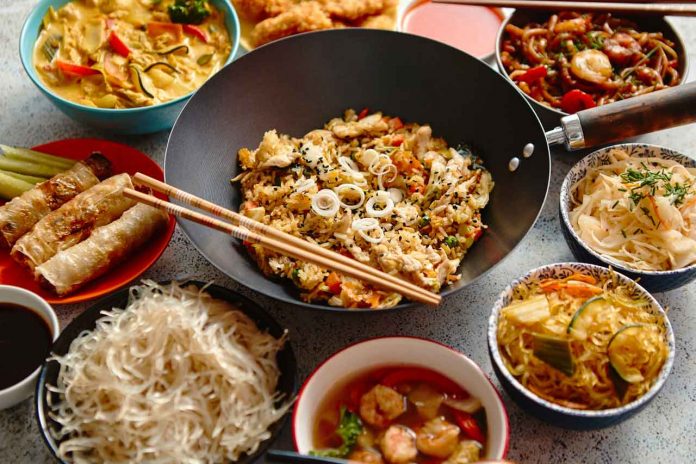Making Chinese food at home can be a fun and rewarding experience. It allows you to explore new flavors and techniques, and it can be a great way to bond with friends and family over a delicious meal. To start, it’s important to gather all the necessary ingredients, which can often be found at your local grocery store or Asian market. Some staple ingredients in Chinese cuisine include soy sauce, sesame oil, rice vinegar, ginger, garlic, and Chinese five-spice powder.
Once you have your ingredients, you can begin experimenting with different recipes. Stir-fry dishes are a great place to start, as they are relatively simple to prepare and can be customized with your favorite vegetables and proteins. You can also try your hand at making dumplings or noodles from scratch, which can be a fun and challenging project. With a little practice and patience, you can create delicious Chinese meals in the comfort of your own home.
Getting Started Making Chinese Food
To make really great Chinese food, you need the right tools. First off is a wok.
A wok is a versatile cooking pan that originated in China and is commonly used in many Asian countries. It has a round bottom and high, sloping sides that make it ideal for stir-frying, deep-frying, steaming, and boiling. The shape of the wok allows for even heat distribution, which is crucial for achieving the crispy texture and caramelization that is characteristic of stir-fry dishes. The high sides of the wok also make it easy to toss ingredients without spilling, which is an important part of the stir-frying technique.
The best wok depends on your personal preference, cooking style, and budget. There are different types of woks made from different materials, shapes, and sizes. Some of the factors to consider when choosing a wok are:
- Material: Woks can be made from carbon steel, cast iron, stainless steel, aluminum, or nonstick coating. Carbon steel is the most popular and traditional material for woks, as it heats up quickly, sears food well, and develops a nonstick patina over time. Cast iron is also good for heat retention and browning, but it is heavier and more prone to rusting. Stainless steel is durable and easy to clean, but it does not conduct heat evenly and may cause food to stick. Aluminum is lightweight and inexpensive, but it may warp or dent easily. Nonstick coating is convenient and requires less oil, but it may not withstand high temperatures and may scratch or peel off.
- Shape: Woks can have either a round bottom or a flat bottom. Round-bottomed woks are more traditional and allow for better tossing and stirring of food, but they require a special ring or burner to fit on a regular stove. Flat-bottomed woks are more stable and compatible with most stoves, but they may not heat up as evenly or create as much wok hei (the smoky flavor from stir-frying).
- Size: Woks can range from 10 inches to 16 inches in diameter, depending on how much food you want to cook at once. A larger wok can hold more ingredients and create more steam, but it may also be heavier and harder to maneuver. A smaller wok can heat up faster and use less oil, but it may also overcrowd the food and cause it to stew rather than stir-fry.
- Handle: Woks can have either one long handle, two loop handles, or a combination of both. A long handle is useful for tossing and flipping food, but it may also get in the way of a lid or take up more space. Loop handles are easier to store and carry, but they may also get hot and require oven mitts. Some woks have a long handle on one side and a loop handle on the other, which offers the best of both worlds.
Based on these factors, some of the best woks according to various sources are:
- Best overall: Yosukata carbon steel 14-inch flat-bottom wok1. This wok is made from carbon steel and has a flat bottom that works on most stoves. It has a long wooden handle and a loop handle for easy handling. It heats up quickly, sears food well, and develops a nonstick patina over time. It is also affordable and durable.
- Best for beginners: Calphalon Premier nonstick wok2. This wok is made from hard-anodized aluminum and has a nonstick coating that makes it easy to clean and use. It has a flat bottom that works on most stoves, including induction. It has a long stainless steel handle and a loop handle for easy handling. It is also oven-safe and dishwasher-safe.
- Best nonstick and budget-friendly: T-fal nonstick wok2. This wok is made from aluminum and has a nonstick coating that makes it easy to clean and use. It has a flat bottom that works on most stoves, including induction. It has a long silicone handle and a loop handle for easy handling. It also has a Thermo-Spot heat indicator that shows when the wok is preheated. It is also oven-safe and dishwasher-safe.
- Best carbon steel and budget-friendly: Yosukata carbon steel wok2. This wok is similar to the best overall wok, but it has a round bottom that requires a ring or a special burner to fit on a regular stove. It is also slightly smaller at 13.5 inches in diameter. It is made from carbon steel and has a long wooden handle and a loop handle for easy handling. It heats up quickly, sears food well, and develops a nonstick patina over time. It is also affordable and durable.
- Best for camping: Lodge Pro-Logic cast iron wok2. This wok is made from cast iron and has a flat bottom that works on most stoves, including campfires. It has two loop handles for easy handling. It retains heat well, browns food well, and lasts a lifetime. It is also pre-seasoned and ready to use. It is also oven-safe.
What Ingredients Do You Need
To make great Chinese food at home, you need some essential ingredients that are widely used in different regional cuisines of China. Some of the most common ones are:
- Soy sauce1: A salty, savory, and umami condiment made from fermented soybeans. There are two types: light soy sauce and dark soy sauce. Light soy sauce is used to add flavor without much color, while dark soy sauce is used to add color and a slightly sweet taste.
- Shaoxing wine2: A cooking wine made from fermented glutinous rice. It adds a nutty and caramelized flavor to dishes such as steamed seafood, braised meat, and wonton soup. You can substitute it with dry sherry if you can’t find it.
- Five-spice powder2: A spice blend that contains star anise, cloves, cinnamon, Sichuan peppercorn, and fennel seed. It covers the full range of flavors: sweet, sour, bitter, salty, and umami. It is used to season meat, poultry, and vegetables.
- Rice vinegar1: A fruity and slightly sweet vinegar made from rice. It is used to add acidity and balance to dishes such as stir-fried noodles, dumplings, and salads. You can substitute it with apple cider vinegar or white wine vinegar if you can’t find it.
- Oyster sauce1: A thick and dark sauce made from oyster extract. It is salty, savory, and a bit sweet. It is used to enhance the flavor of dishes such as broccoli beef, eggplant, and lo mein.
- Fermented black bean sauce2: A potent and addictive sauce made from fermented black beans, dried chilies, cooking wine, soy sauce, brown sugar, and cornstarch. It adds a rich and spicy taste to dishes such as mapo tofu, steamed fish, and chicken wings.
The Internet is a virtual gold mine of resources on how to make your favourite Asian dishes at home.
From making fried rice to Ginger Fried Beef, you can make Chinese food at home that is delicious and healthy too.
It is a far step up from pouring sugary sweet and sour sauce over fried chicken balls.
Dig in to it and you will find likely skills you didn’t think you had, and you can involve the teens and even younger children into the preparation of delicious meals.







